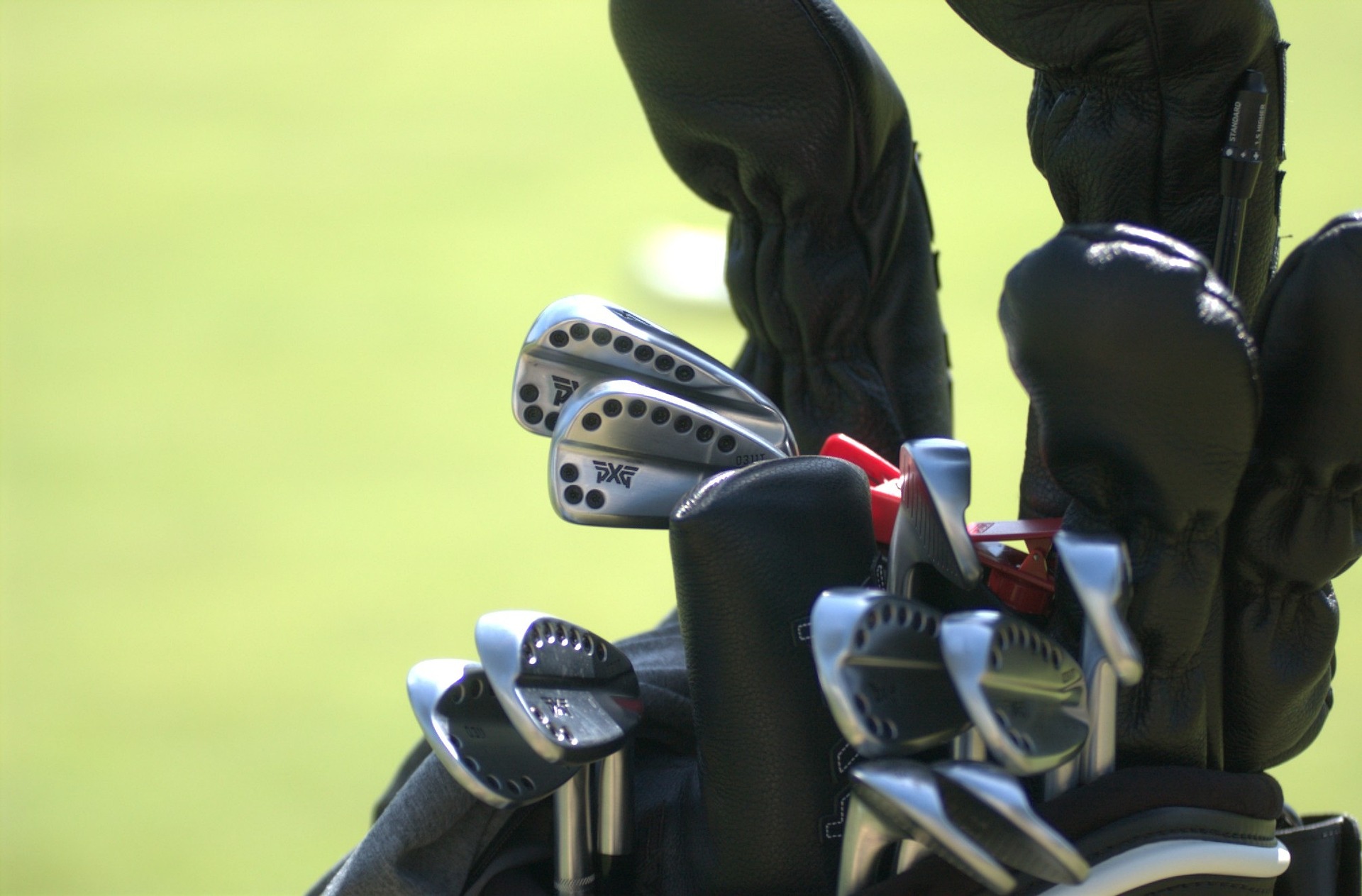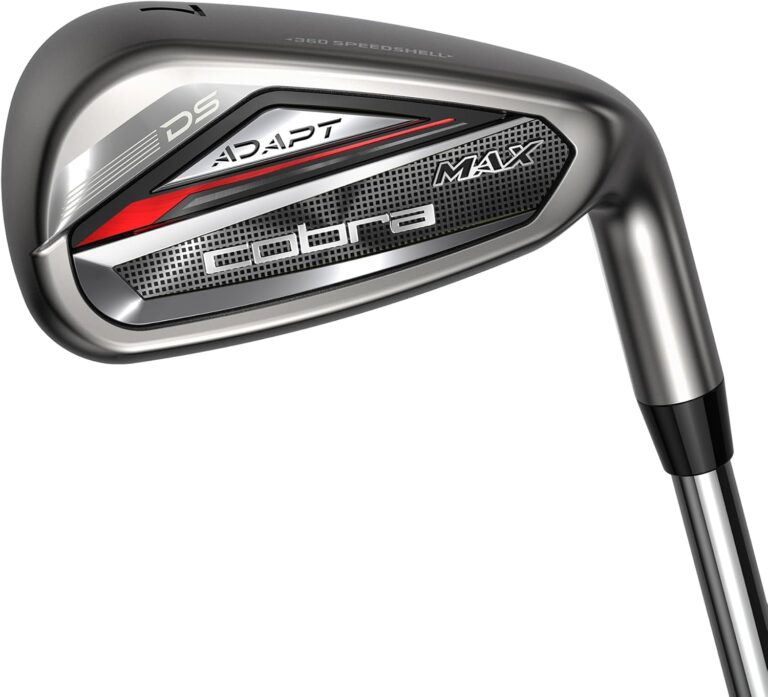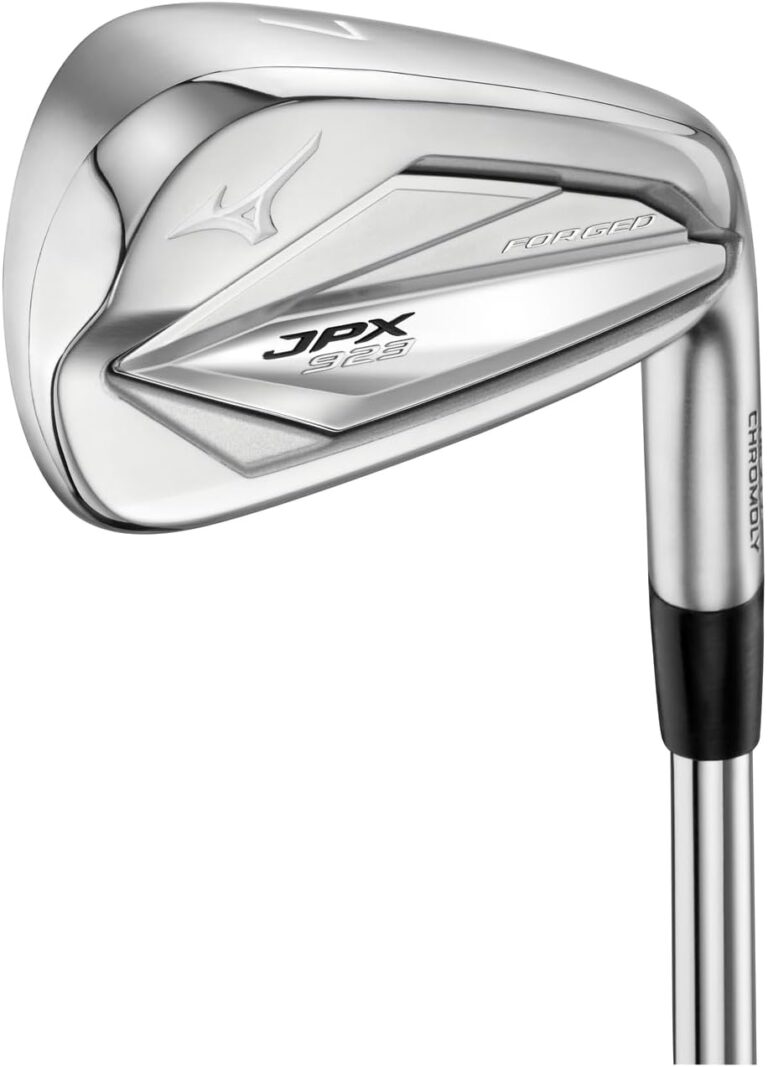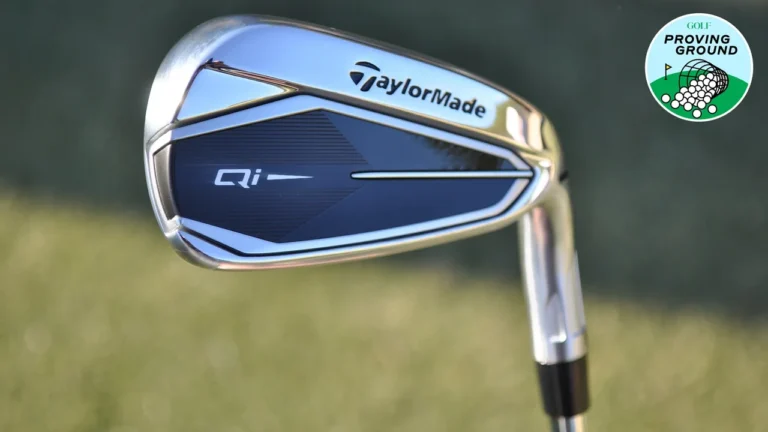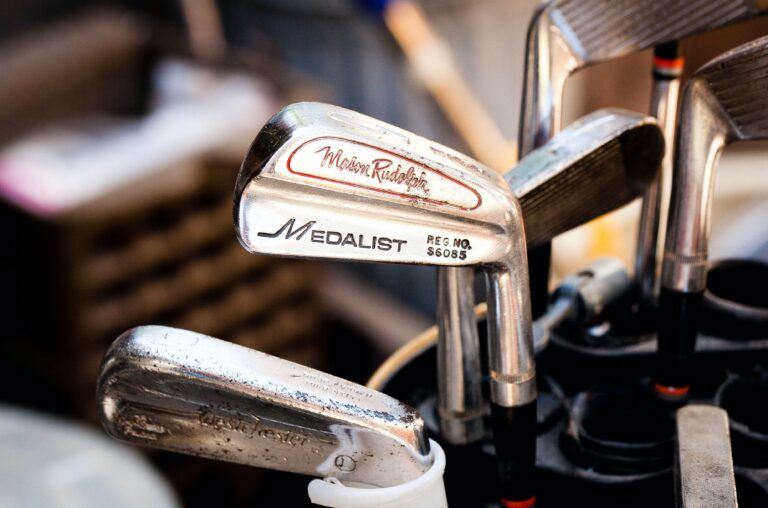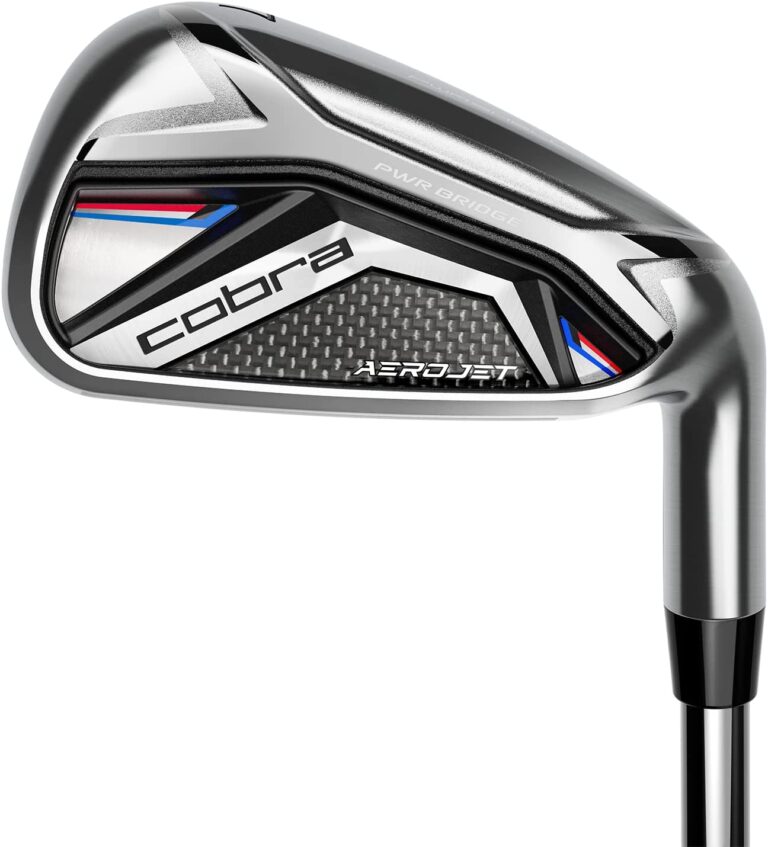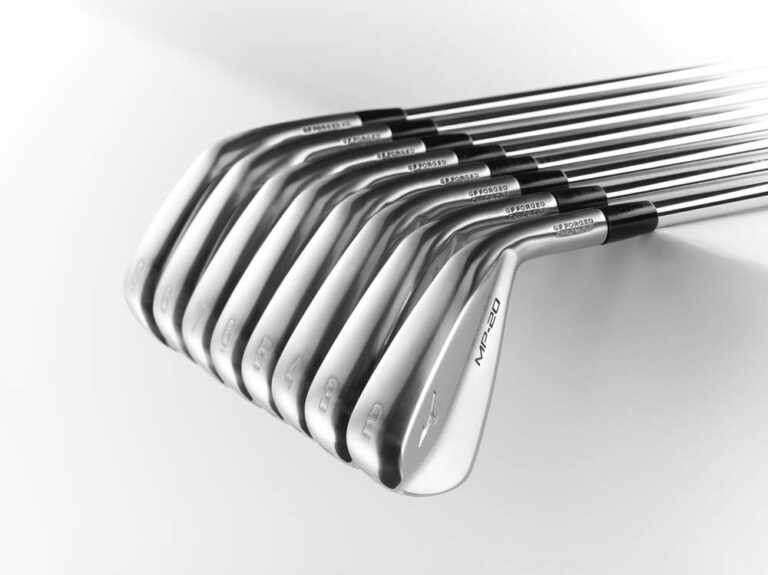Best Cavity back irons
Golf is a sport that requires precision and accuracy, and having the right set of irons can make all the difference in a player’s game.
Cavity back irons are a popular choice among golfers of all skill levels. They offer forgiveness and a larger sweet spot, making it easier to hit the ball consistently.
In this article, we will take a closer look at the best cavity back irons available in 2023, as well as what makes them stand out from the competition.
What are Cavity Back Irons?
Cavity back irons are designed with a hollowed-out cavity on the back of the club head, which helps to redistribute weight and create a larger sweet spot. This makes them a great option for golfers who struggle with consistency or have a higher handicap.
The larger sweet spot also helps to reduce the amount of spin on the ball, resulting in a straighter shot with more distance. With so many options available on the market, it can be difficult to know which set of cavity back irons is right for you.
By examining the features and benefits of the top-rated sets, we hope to provide a comprehensive overview of the best options available in 2023.
Features to Consider
When looking for the best cavity back irons, there are several features to consider. These include forgiveness, feel, and distance control. Each of these features plays an important role in determining the overall performance of the iron.
Forgiveness
Forgiveness is a crucial feature to consider when selecting cavity back irons. It refers to the club’s ability to minimize the impact of mishits and provide consistent results. A club with high forgiveness will help players maintain accuracy and distance, even when they don’t hit the ball perfectly.
Cavity back irons are generally more forgiving than blade irons because they have a larger sweet spot. The sweet spot is the area of the clubface that produces the most consistent results. With a larger sweet spot, cavity back irons are more forgiving on off-center hits.
Feel.
Feel is another important feature to consider when selecting cavity back irons. It refers to the feedback that the club provides when the ball is struck. A club with a good feel will provide players with a sense of confidence and control over their shots.
Cavity back irons are typically designed to provide a softer feel than blade irons. This is because they have a cavity in the back of the club head, which allows for more weight to be distributed around the perimeter. This design feature helps to absorb vibrations and provide a more comfortable feel on impact.
Distance Control.
Distance control is the ability to consistently hit shots at a desired distance. It is an important feature to consider when selecting cavity back irons because it can have a significant impact on a player’s scores.
Cavity back irons are designed to provide a balance between distance and forgiveness. They typically have a lower center of gravity, which helps to launch the ball higher and produce more distance. However, they also have a perimeter weighting system, which helps to provide more forgiveness on off-center hits.
In summary, when selecting cavity back irons, it is important to consider features such as forgiveness, feel, and distance control. These features can have a significant impact on a player’s performance and overall enjoyment of the game.
Cavity Back Irons for Different Skill Levels:
Beginner Golfers.
For beginner golfers, it is essential to choose cavity back irons that offer maximum forgiveness and support. These irons should have a larger sweet spot and a wide sole to help increase launch and reduce mishits.
One recommended option for beginners is the Callaway Golf Apex DCB, known for its exotic appearance and forgiving design.
High Handicap Golfers.
High-handicap golfers need irons that provide consistency, control and added distance. Cavity back irons with a lower center of gravity and perimeter weighting can assist these players in achieving straighter and longer shots.
The TaylorMade P790 is a great option, as it features a sleek and distinctive cavity back design that still offers ample forgiveness for high handicap players.
Game Improvement Irons.
Game improvement irons are tailored for golfers seeking to enhance their overall performance on the course. Some popular game improvement irons include:
- Mizuno JPX 923 Forged Irons: These irons offer the best feel, superb distance, and forgiveness, and are available at a reasonable price.
- Ping i210 Irons: Designed for better players, these irons boast precision milling, improved elastomer in the sole, and excellent playability.
To make the best choice, golfers should consider their skill level, specific needs, and preferences when selecting cavity back irons.
Top Cavity Back Iron Models:
Here are our picks for the top 10 best-rated Cavity back iron models.
1. Callaway Apex DCB Irons.
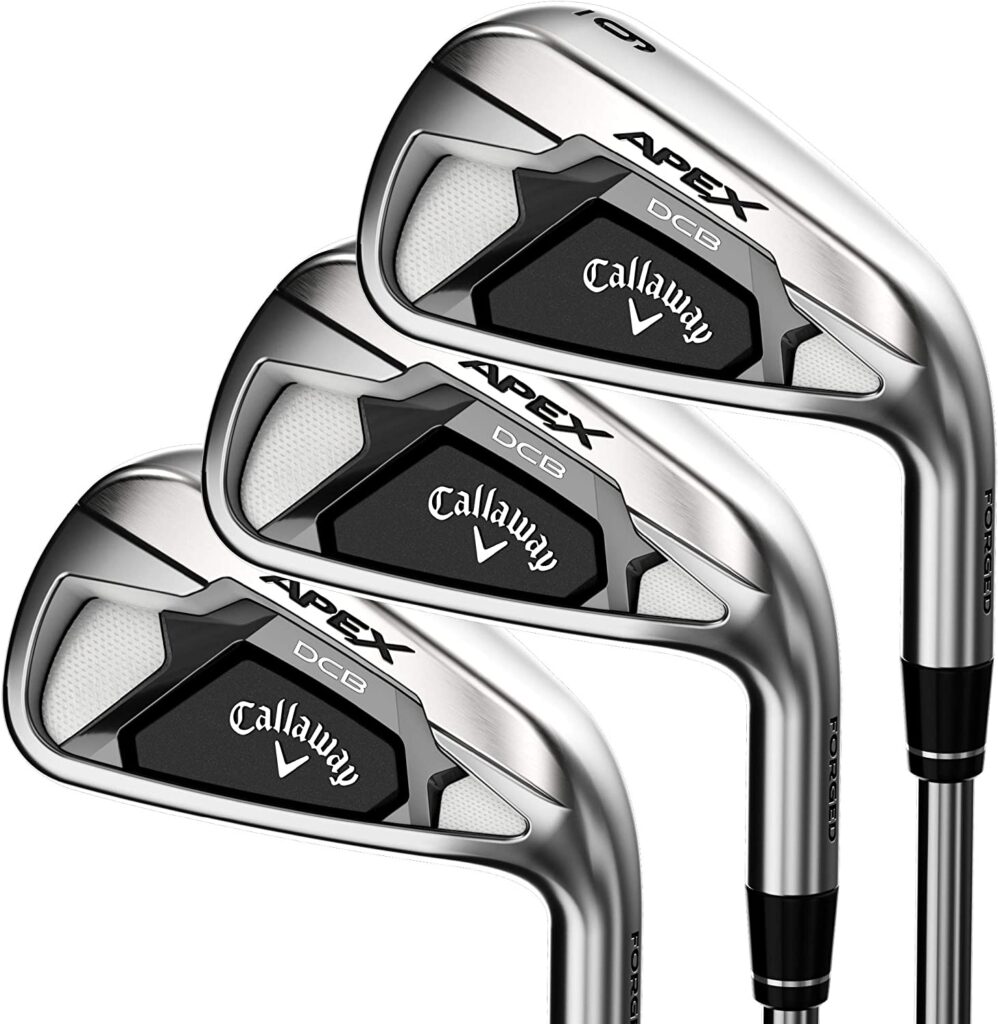
Callaway Apex DCB Irons are one of the most easily recognized best Cavity back irons and are designed to offer the performance of Apex Irons with enhanced forgiveness and a larger clubhead, making them suitable for a wide range of golfers. Here’s an overview of their key features, pros, and cons:
Key Features:
- A.I. Designed Flash Face Cup: This technology uses artificial intelligence to optimize the face design for faster ball speeds and increased distance.
- Deep Cavity Back Design: The deep cavity back increases the club’s moment of inertia (MOI), leading to greater forgiveness on off-center hits.
- Tungsten Energy Core: Tungsten weights are strategically placed to lower the center of gravity, promoting optimal launch angles and maximizing ball speed.
- Urethane Microspheres: These tiny air pockets within the clubhead absorb vibrations and provide a soft, satisfying feel without sacrificing ball speed.
- Forged 1025 Carbon Steel Body: The forging process results in a soft, solid feel and a premium look.
Pros:
- Forgiveness: The deep cavity back design offers increased forgiveness on mis-hits.
- Distance: The A.I. Designed Flash Face Cup provides impressive ball speed and distance.
- High Launch: The Tungsten Energy Core helps achieve higher launch angles for easier shots.
- Feel: Urethane Microspheres and the forged carbon steel body contribute to a soft and satisfying feel at impact.
- Versatility: The design suits a wide range of golfers, from beginners to low handicappers seeking more forgiveness.
Cons:
- Price: The Callaway Apex DCB Irons may be expensive for some golfers, especially beginners or casual players.
- Less Workability: The larger clubhead and focus on forgiveness can make it more challenging to shape shots and control ball flight compared to players’ irons.
- Aesthetics: Some golfers might find the larger clubhead and thicker top line visually unappealing.
Taylormade SIM 2 Irons.
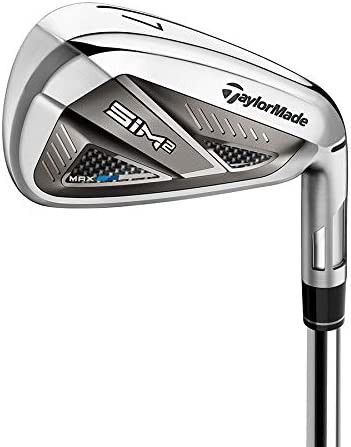
TaylorMade SIM2 Max Irons is one of the best back Cavity irons and are designed to provide maximum distance, forgiveness, and a high launch angle, making them suitable for a wide range of golfers, especially those with mid to high handicaps. Here’s an overview of their key features, pros, and cons:
Key Features:
- Cap Back Design: This unique construction replaces the traditional cavity back, providing more forgiveness and a higher MOI while maintaining a traditional iron shape.
- Fast Forgiving Face: The ultra-thin face design increases ball speed and distance, while the sweet spot is expanded for better performance on off-center hits.
- Thru-Slot Speed Pocket: This technology maximizes face flexibility and promotes faster ball speeds, especially on low-face strikes.
- Progressive Inverted Cone Technology (ICT): ICT is designed to improve accuracy and minimize the effects of mis-hits by strategically positioning the inverted cone on each iron face.
- ECHO Damping System: This system uses a soft polymer blend and multiple contact points across the face to reduce vibrations and provide a soft, solid feel at impact.
Pros:
- Forgiveness: The Cap Back Design and expanded sweet spot offer increased forgiveness on mis-hits.
- Distance: Fast Forgiving Face and Thru-Slot Speed Pocket technologies contribute to impressive ball speed and distance.
- High Launch: The design of the SIM2 Max Irons promotes a high launch angle, making it easier to get the ball in the air.
- Feel: The ECHO Damping System reduces vibrations for a comfortable and satisfying feel at impact.
- Consistency: Progressive Inverted Cone Technology enhances accuracy and consistency across the set.
Cons:
- Price: TaylorMade SIM2 Max Irons might be on the expensive side for some golfers, particularly beginners or occasional players.
- Workability: The focus on forgiveness and distance may limit shot-shaping capabilities compared to more traditional players’ irons.
- Aesthetics: Some golfers may prefer a more compact clubhead or thinner top line
1. Mizuno JPX 923 Forged Irons
The Mizuno JPX 923 Forged Irons combine the excellent feel and feedback of a forged club with the forgiveness and playability of a cavity-back design. These irons offer impressive distance control and precision, making them a great choice for players looking to improve their iron play. Some key features include:
- Grain Flow Forged HD process for enhanced feel and feedback
- Chromoly 4120 face and neck for increased ball speed
- Stability Frame design for improved forgiveness and stability
2. Mizuno JPX 923 Tour Irons.
The Mizuno JPX 923 Tour Irons are a sleek and compact option for better players who appreciate the look and feel of a traditional forged blade, but still seek the advantages of a cavity back. These irons boast precision and control for improved shot-making capabilities. Key features include:
- Grain Flow Forged HD process for a soft yet solid feel
- Shorter blade length and compact head for precise shot-making
- Narrow soles and thinner topline for a tour-inspired look
3. Mizuno JPX 923 Hot Metal Pro Irons.
The Mizuno JPX 923 Hot Metal Pro Irons are designed to maximize distance while maintaining playability and forgiveness. These irons feature Mizuno’s innovative Chromoly 4140M material, which enhances ball speeds, especially on off-center hits. Key highlights include:
- Chromoly 4140M material for increased ball speed and distance
- Re-engineered CORTECH face for faster ball speeds across the face
- Sound ribs for improved feel at impact
4. Ping i210 Irons
Ping i210 Irons are popular for their combination of precision, feel, and forgiveness. They are aimed at better players seeking control and consistency in their iron game. These irons showcase:
- Precision-milled faces for improved playability
- Elastomer insert in the sole for enhanced feel and sound
- HydroPearl 2.0 finish for better turf interaction
5. Ping G430 Iron Set.
Although not released at the time of writing, the anticipated Ping G430 Iron Set promises to improve upon the highly successful G-series irons. As a continuation of Ping’s tradition of innovation in cavity-back designs, the G430 Iron Set is expected to offer golfers a blend of distance, forgiveness, and playability.
In conclusion, the cavity-back iron market is rife with options for golfers, with Mizuno and Ping offering a range of models to cater to different skill levels, preferences, and optimization goals.
Whether seeking distance, control, or forgiveness, these models deliver top-quality performance to help golfers improve their game.
Cavity Back Irons vs Muscle Back Irons
Cavity back irons and muscle back irons are two different types of golf club irons that cater to different skill levels and preferences. Understanding the key differences between them will help golfers choose the right type of irons for their game.
Cavity back irons are designed with forgiveness and distance in mind. The clubhead features a hollow cavity at the rear, which redistributes the weight toward the perimeter of the clubhead.
This design lowers the center of gravity, produces a higher ball flight, and increases the sweet spot size, making cavity back irons ideal for beginners and high-handicap golfers who may not always hit the ball at the center of the clubface (source).
Moreover, the larger sweet spot reduces the impact of mishits and helps golfers achieve more distance on off-center shots.
On the other hand, muscle back irons, often referred to as blades, offer more control and shot-shaping capabilities. These irons have a more compact clubhead with less mass at the rear, which results in a higher center of gravity and a smaller sweet spot (source).
This design is tailored to accommodate low-handicap golfers who prioritize precision and control over forgiveness. Muscle back irons require more skill and a consistent, precise center of the clubhead hit to perform well.
Below is a summary of the characteristics of both types of irons:
| Cavity Back Irons | Muscle Back Irons |
|---|---|
| Larger sweet spot | Smaller sweet spot |
| More forgiving | Less forgiving |
| Higher ball flight | Lower ball flight |
| Suited for beginners and high-handicap players | Suited for low-handicap players |
In summary, golfers should consider their skill level, preferences, and goals when choosing between cavity back and muscle back irons.
Cavity back irons are more forgiving, which suits beginners and high-handicap players who may require extra assistance with mishits.
Meanwhile, muscle back irons cater to low-handicap golfers who value control and shot-shaping capabilities over forgiveness.
Benefits of Cavity Back Irons.
Forgiveness:
Cavity back irons are known for their forgiveness compared to other iron types like muscle backs or blades.
This is due to their design which involves a hollow cavity at the back of the club head, allowing for weight distribution towards the perimeter. This feature increases the moment of inertia (MOI), making it easier for golfers to achieve consistent shots, even when they mishit the ball.
For players, high forgiveness translates into less penalizing outcomes for off-center hits, which can contribute to more enjoyable and lower-scoring rounds on the golf course.
Increased Ball Speed:
Another benefit of cavity back irons is the increased ball speed that they can generate. According to Golf Span, the multi-material construction of some cavity back irons promotes better feel, forgiveness, and distance.
High ball speed is typically achieved due to the club’s design, which can include thin clubfaces or certain materials that promote a trampoline effect upon impact.
This results in shots that travel farther and more accurately, making them particularly helpful for golfers who struggle to cover longer distances on the golf course.
Sweet Spot:
Cavity back irons are also known for having an expanded sweet spot compared to other iron types. The increased MOI and perimeter weighting work together to enlarge the area on the clubface where a well-struck shot is generated.
When a golfer connects with the sweet spot, they can experience better ball control and improved shot outcomes.
This aspect of cavity back irons is particularly beneficial for beginner and intermediate golfers, who may not yet have the consistency or skill to strike the ball in the smaller sweet spots found on blades or muscle-back irons.
In summary, cavity back irons provide players with significant advantages, particularly in terms of forgiveness, increased ball speed, and an expanded sweet spot.
These characteristics make them an excellent option for a wide range of golfers, particularly those who are still developing their skills and striving for consistent shot outcomes.
Conclusion
In this article, we have discussed some of the top cavity back irons available in the market for golfers of all skill levels. These irons are designed to provide a perfect combination of forgiveness, distance, and control, making them essential additions to any golfer’s bag.
Among the top choices for cavity back irons are the Mizuno JPX 923 Forged Irons, which offer exceptional feel, distance, and forgiveness at a reasonable price. This set is a top recommendation for golfers in 2023.
Another notable option is the Callaway Golf Apex DCB, which features a unique design that combines classic forged iron characteristics with a forgiving clubface. This makes it an excellent choice for golfers looking for an all-around cavity back iron.
For low handicap golfers, the Ping i210 Irons stands out as a top pick, offering precision milling and technology upgrades from the i200 series. The larger elastomer in the sole adds to the feel and overall performance of the club.
Golfers seeking distance should consider the Callaway 2020 Mavrik Max Iron Set for its ball speed and perfectly placed weights, providing a solid foundation for long drives and consistent shots.
In conclusion, selecting the ideal cavity back iron depends on a golfer’s specific needs and skill level. The options mentioned in this article provide a comprehensive range of features and benefits, catering to a diverse range of golfers. By investing in a high-quality cavity back iron, players can enhance their golf game and ultimately lower their scores on the course

